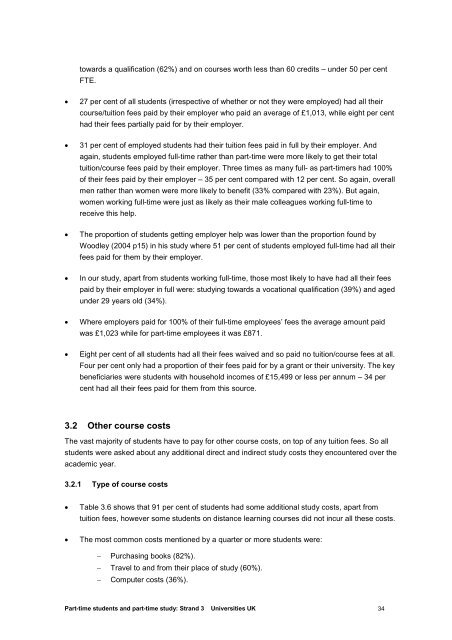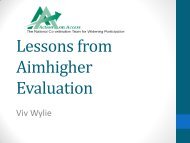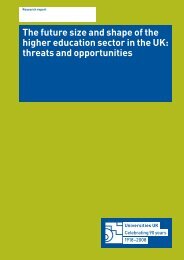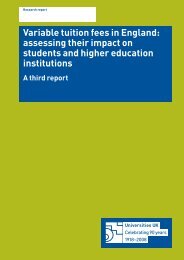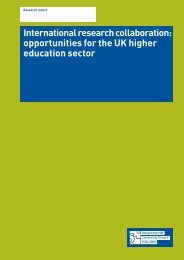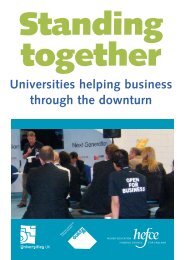Part-time Students And part-time Study In Higher ... - Universities UK
Part-time Students And part-time Study In Higher ... - Universities UK
Part-time Students And part-time Study In Higher ... - Universities UK
Create successful ePaper yourself
Turn your PDF publications into a flip-book with our unique Google optimized e-Paper software.
towards a qualification (62%) and on courses worth less than 60 credits – under 50 per centFTE.• 27 per cent of all students (irrespective of whether or not they were employed) had all theircourse/tuition fees paid by their employer who paid an average of £1,013, while eight per centhad their fees <strong>part</strong>ially paid for by their employer.• 31 per cent of employed students had their tuition fees paid in full by their employer. <strong>And</strong>again, students employed full-<strong>time</strong> rather than <strong>part</strong>-<strong>time</strong> were more likely to get their totaltuition/course fees paid by their employer. Three <strong>time</strong>s as many full- as <strong>part</strong>-<strong>time</strong>rs had 100%of their fees paid by their employer – 35 per cent compared with 12 per cent. So again, overallmen rather than women were more likely to benefit (33% compared with 23%). But again,women working full-<strong>time</strong> were just as likely as their male colleagues working full-<strong>time</strong> toreceive this help.• The proportion of students getting employer help was lower than the proportion found byWoodley (2004 p15) in his study where 51 per cent of students employed full-<strong>time</strong> had all theirfees paid for them by their employer.• <strong>In</strong> our study, a<strong>part</strong> from students working full-<strong>time</strong>, those most likely to have had all their feespaid by their employer in full were: studying towards a vocational qualification (39%) and agedunder 29 years old (34%).• Where employers paid for 100% of their full-<strong>time</strong> employees’ fees the average amount paidwas £1,023 while for <strong>part</strong>-<strong>time</strong> employees it was £871.• Eight per cent of all students had all their fees waived and so paid no tuition/course fees at all.Four per cent only had a proportion of their fees paid for by a grant or their university. The keybeneficiaries were students with household incomes of £15,499 or less per annum – 34 percent had all their fees paid for them from this source.3.2 Other course costsThe vast majority of students have to pay for other course costs, on top of any tuition fees. So allstudents were asked about any additional direct and indirect study costs they encountered over theacademic year.3.2.1 Type of course costs• Table 3.6 shows that 91 per cent of students had some additional study costs, a<strong>part</strong> fromtuition fees, however some students on distance learning courses did not incur all these costs.• The most common costs mentioned by a quarter or more students were:− Purchasing books (82%).− Travel to and from their place of study (60%).− Computer costs (36%).<strong>Part</strong>-<strong>time</strong> students and <strong>part</strong>-<strong>time</strong> study: Strand 3 <strong>Universities</strong> <strong>UK</strong> 34


